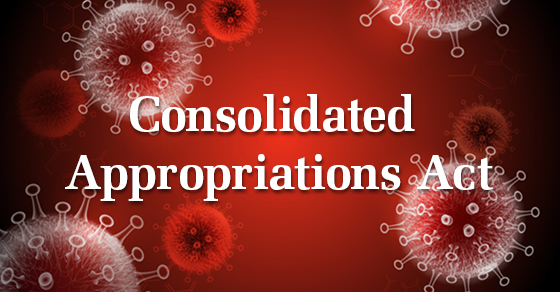
The Consolidated Appropriations Act, 2021 (“CAA”) was signed into law in late December. The sprawling legislation contains billions of dollars in additional stimulus funding in response to the COVID-19 pandemic, numerous tax law changes, and many unrelated provisions. The focus of this article is on the tax law changes that we expect are most likely to impact our clients, as well as updates to the Paycheck Protection Program, which provided an important lifeline to so many businesses during the past year.
Paycheck Protection Program
The CAA includes another $284 billion in funding for forgivable loans through the Paycheck Protection Program (PPP), for both first-time and second draw borrowers. New loans can be made through March 31, 2021, or until the funding is exhausted. The new law expands the allowable uses for PPP funds, provides a simplified forgiveness process for smaller loans, and clarifies the proper tax treatment of loan proceeds and forgiven amounts.
PPP Expense Deductibility
As we briefly covered in our prior tax update on December 28th, the CAA clarifies that borrowers need not include any forgiven loan amounts in taxable income and that borrowers can deduct otherwise deductible expenses paid with forgiven PPP loan funds. The CAA also provides that tax basis and other attributes aren’t reduced by loan forgiveness. Passthrough businesses that receive loan forgiveness after 2020 may have timing issues which prevent their owners from having sufficient basis to deduct losses in 2020, so passthrough businesses with PPP loan forgiveness are encouraged to have a planning discussion with their tax advisor.
PPP Second Draw Loans
The second draw loans are intended for smaller and harder hit businesses. Eligible borrowers include businesses, certain nonprofits, self-employed individuals, sole proprietors, and independent contractors.
To qualify for a second draw, borrowers must have no more than 300 employees and must have used (or will use) all of the proceeds from their first PPP loan. Borrowers generally also must demonstrate at least a 25% reduction in gross receipts in one quarter of 2020 compared with the same quarter in 2019.
Loans are limited to 2.5 times average monthly payroll costs in the year prior to the loan or the calendar year, up to $2 million. Accommodation and food service businesses may receive loans for up to 3.5 times their average monthly payroll. Businesses can obtain only one second draw loan, and businesses with multiple locations that are eligible under the initial PPP requirements can have no more than 300 employees per physical location.
The CARES Act, which created the PPP, limited allowable uses of forgivable loan funds to payroll, mortgage, rent, and utility payments. The CAA expands the allowable uses to include the following additional expenses:
- Covered operating expenses, including software or cloud computing services that facilitate business operations, product and service delivery, payroll processing, human resources, sales and billing, accounting or tracking supplies, inventory, records, and expenses,
- Uninsured costs related to property damage, vandalism or looting during 2020 public disturbances,
- Supplier costs according to a contract, purchase order or order for goods, in effect before taking out the loan, that are essential to the borrower’s operations, and
- Worker protection expenses incurred to comply with federal or state health and safety guidelines related to COVID-19 (for example, personal protective equipment, ventilation systems and drive-through windows).
As with the first round of PPP loans, in order to receive full forgiveness, a business must spend at least 60% of the funds on payroll over the covered period, which may range from 8 to 24 weeks.
Other changes to the PPP made by the CAA including the following:
- A simplified forgiveness application for loans up to $150,000.
- Elimination of the previous requirement that borrowers deduct the amount of any SBA Economic Injury Disaster Loan (EIDL) advances from their PPP forgiveness amount.
When and How to Apply:
The PPP application process reopens for all banks on January 19th. Certain smaller community lenders and lenders serving underserved populations were able to start applying about one week earlier. The application deadline is March 31, 2021, or when the funding runs out. In seeking a first or second round PPP loan, businesses may fare best by starting with their existing lender relationships. Alternatively, the SBA has resources to help match businesses with PPP lenders.
Economic Impact Payments
The year-end legislation provides a new economic impact payment in the amount of $600 per eligible family member ($1,200 if you file a joint return with your spouse), plus $600 for each qualifying child. The impact payment phases out starting at $75,000 of income ($112,500 for heads of household and $150,000 for married taxpayers filing jointly) and is completely phased out at $87,000 of income ($124,500 for head of household and $174,000 for married taxpayers filing jointly).
Because the rebates are based on your 2019 tax return, you could receive a payment that is less than the amount you are entitled to under the law. If your income was lower in 2020 or your family grew, you may be able to claim an additional credit for the difference on your 2020 tax return. If you receive a payment and it turns out based on your actual 2020 income that your payment should have been phased out, you won’t have to repay the difference.
The IRS and Treasury have begun issuing these payments, but it will take several weeks or longer for all qualifying taxpayers to receive their payments. Some taxpayers may need to file their 2020 tax return in order to claim and receive the correct payment.
You may check the status of your economic impact payments using the IRS’s Get My Payment tool.
Extension and Expansion of the Employee Retention Credit
Background
To encourage businesses to maintain their workforces, the CARES Act created the Employee Retention Credit (“ERC”), a refundable credit against payroll tax for employers whose:
- Operations were fully or partially suspended due to a COVID-19-related governmental shutdown order, or
- Gross receipts dropped more than 50% compared to the same quarter in the previous year (until gross receipts exceed 80% of gross receipts in the earlier quarter).
Employers with more than 100 employees could receive the credit only for wages paid to employees while they were not providing services due to COVID-19 circumstances. Those with 100 or fewer employees received the credit for wages paid regardless of whether or not the employee was providing services.
The credit equaled 50% of up to $10,000 in compensation — including health care benefits — paid to an eligible employee from March 13, 2020, through December 31, 2020.
Enhancements Made by the CAA
The CAA extends the credit for eligible employers that continue to pay wages during COVID-19 closures or reduced revenue through June 30, 2021.
Notably, as of January 1, 2021, the CAA increases the credit from 50% of qualified wages to 70%. It also expands eligibility by reducing the requisite year-over-year gross receipt reduction from 50% to only 20% and raises the limit on per-employee creditable wages from $10,000 for the year to $10,000 per quarter.
In addition, the threshold for a business to be deemed a “large employer” — and thus subject to a tighter standard when determining the qualified wage base — is lifted from 100 to 500 employees.
The CAA also includes some retroactive clarifications and technical improvements regarding the original credit. An important technical improvement allows employers that receive PPP loans to also claim the Employee Retention Credit for wages not paid with forgiven PPP funds. A business may not “double dip” by claiming PPP loan forgiveness and the ERC with respect to the same wages. However, the business may be able to receive full loan forgiveness by including non-wage allowable expenditures in its forgiveness calculation and saving some of the wages for claiming the ERC, thereby maximizing its allowable federal relief benefits.
Extension of Paid Family and Sick Leave and Related Tax Credits
The CAA extends the refundable payroll tax credits for paid sick and family leave, enacted in the Families First Coronavirus Response Act, through the end of March 2021. It also modifies the payroll tax credits so that they apply as if the corresponding employer paid leave mandates were extended through March 31, 2021.
Business Meals Deduction at 100% for 2021-2022
The new tax law contains a tax-favorable change to the deduction for business meals. It temporarily allows a 100% business expense deduction for business-related meals (rather than the prior 50%) if the expense is for food or beverages provided by a restaurant. This provision is effective for expenses incurred after Dec. 31, 2020 and expires at the end of 2022.
Extension of Charitable Contribution Deduction Expansions under CARES Act
The CARES Act allowed taxpayers who do not itemize deductions to claim a $300 “above-the-line” deduction for cash contributions to qualified charitable organizations in 2020. The CAA extends that deduction through 2021 and doubles the allowable deduction for married filers in 2021 to $600. Note that contributions to donor-advised funds do not qualify for this deduction.
The CARES Act also loosened the limitations on charitable deductions for cash contributions made in 2020, boosting it from 60% to 100% of AGI for individual taxpayers and from 10% to 25% of taxable income for corporate taxpayers. The CAA extends those higher thresholds for 2021. Note that contributions to donor-advised funds also do not qualify for the higher limitation.
Charitable Contributions for Disaster Relief
The CAA also allows corporations to deduct up to 100% of taxable income for charitable contributions for disaster relief: 1) Qualified contributions must be paid by a corporation from Jan. 1, 2020, through Feb. 25, 2021; 2) cash contributions to most charitable organizations qualify for the increased limit; 3) “qualified disaster areas” don’t include declarations related to COVID-19; and 4) contributions made to a supporting organization or to establish or maintain a donor-advised fund don’t qualify.
Medical Expense Deduction Threshold
For tax years beginning before January 1, 2021, you could claim an itemized deduction for unreimbursed medical expenses that exceeded 7.5% of your adjusted gross income (AGI). The threshold was scheduled to increase to 10% of AGI for 2021, which would make it more difficult to qualify for a medical expense deduction. The CAA makes the 7.5% of AGI threshold permanent for tax years beginning after December 31, 2020.
Extended Timeline for Repayment of Deferred Employee Payroll Taxes
Businesses were given the option to defer the withholding and deposit of the employee share of Social Security taxes from September 1, 2020, through December 31, 2020 for employees under a $104,000 annualized income threshold. Employers that implemented this deferral were originally directed to increase the withholding and pay the deferred amounts on a prorated basis from wages and compensation paid between January 1, 2021, and April 30, 2021. Under the CAA, these employers now have all of 2021 to withhold and pay the deferred taxes.
30 Year ADS Life for Pre-2018 Residential Real Estate with a Real Property Trade or Business Election under 163(j)
A real property trade or business that elects out of the deduction limitations for business interest under Code Sec. 163(j) and is required to depreciate all of its residential rental property using ADS beginning with the tax year of election may use a 30-year ADS recovery period to depreciate residential rental property placed in service before 2018. Previously, a 30-year ADS period only applied to residential rental property placed in service after 2017 and a 40-year period applied to residential rental property placed in service before 2018. This change will require some additional computations and reporting in connection with the 2020 tax return filing.
Changes to Income Thresholds for Education Credits and Post 2020 Repeal of the Tuition Deduction
Qualified taxpayers generally can claim an education tax break with the American Opportunity Tax Credit (AOTC) and the Lifetime Learning Credit (LLC). Previously, the two credits were subject to different phaseout rules, with the AOTC available at a greater modified adjusted gross income (MAGI) than the LLC. In addition, before the new law, taxpayers could claim a “higher education expense deduction” for qualified tuition and related expenses.
The CAA adopts a single phaseout for both the AOTC and the LLC, effective for tax years beginning after December 31, 2020. The credits will phase out beginning at MAGI of $80,000 for single filers (and ending at $90,000). For joint filers, the phase out range is $160,000 to $180,000 of MAGI.
The new law also repeals the higher education expense deduction after 2020.
Optional employer changes to FSA rules
The CAA loosens certain rules related to health and dependent care Flexible Spending Accounts (FSAs) that could otherwise lead to taxpayers forfeiting unspent funds. It allows unused amounts from 2020 FSAs to roll over to 2021 and unused amounts from 2021 FSAs to roll over to 2022. Grace periods for plan years ending in 2021 or 2022 may be extended to 12 months after the end of the plan year. For 2021, employees can make prospective election changes in their FSA contribution amounts during the year without regard to any change in status requirements. These changes are voluntary for employers. If you have an FSA, check with your employer to see if it is adopting any of these changes.
Other Extenders Included in the CAA
The legislation included temporary or permanent extensions to numerous taxpayer beneficial tax provisions. Some of those have been discussed above, and a few more notable extenders include the 45L credit for energy efficient residential dwellings, the 179D deduction for energy efficient commercial property, the work opportunity tax credit, and the credit for paid family and medical leave. The legislation also included various changes to excise taxes related to beer, wine, and spirits and a beneficial change to the interest capitalization rules for businesses producing these beverages. The full list of extenders may be found here.
The CAA is one of the longest pieces of legislation in congressional history. While this summary includes some of the more broadly-applicable provisions, you may also be impacted by other provisions not included above. Please contact us to discuss any questions.




